Related Research Articles
Professional certification, trade certification, or professional designation, often called simply certification or qualification, is a designation earned by a person to assure qualification to perform a job or task. Not all certifications that use post-nominal letters are an acknowledgement of educational achievement, or an agency appointed to safeguard the public interest.

A sanitary sewer is an underground pipe or tunnel system for transporting sewage from houses and commercial buildings to a sewage treatment plant or disposal. Sanitary sewers are a type of gravity sewer and are part of an overall system called a "sewage system" or sewerage. Sanitary sewers serving industrial areas may also carry industrial wastewater. In municipalities served by sanitary sewers, separate storm drains may convey surface runoff directly to surface waters. An advantage of sanitary sewer systems is that they avoid combined sewer overflows. Sanitary sewers are typically much smaller in diameter than combined sewers which also transport urban runoff. Backups of raw sewage can occur if excessive stormwater inflow or groundwater infiltration occurs due to leaking joints, defective pipes etc. in aging infrastructure.
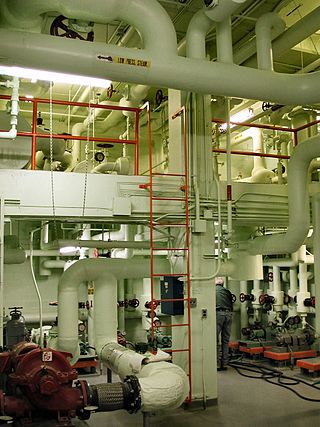
Within industry, piping is a system of pipes used to convey fluids from one location to another. The engineering discipline of piping design studies the efficient transport of fluid.

In modern plumbing, a drain-waste-vent is a system that allows air to enter the plumbing system to maintain proper air pressure to enable the removal of sewage and greywater from a dwelling. Drain refers to water produced at fixtures such as sinks, and showers; waste refers to water from toilets. As the water runs down, proper venting is required to allow water to flow freely, and avoid a vacuum from being created. As the water runs down air must be allowed into the waste pipe either through a roof vent (external), or an internal vent.
In plumbing, a Fixture Unit (FU) or Drain Fixture Unit (DFU) is "a unit of measure, based on the rate of discharge, time of operation and frequency of use of a fixture, that expresses the hydraulic load imposed by that fixture on the sanitary plumbing installation". A Fixture Unit is not a flow rate unit but a design factor. A fixture unit is equal to 1 cubic foot (0.028 m3) of water drained in a 1+1⁄4 inches (32 mm) diameter pipe over one minute. One cubic foot of water is roughly 7.48 US gallons. A Fixture Unit is used in plumbing design for both water supply and waste water.
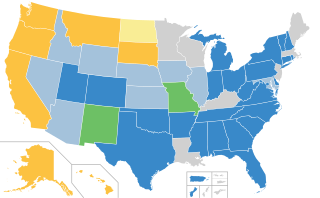
Designated as an American National Standard, the Uniform Plumbing Code (UPC) is a model code developed by the International Association of Plumbing and Mechanical Officials (IAPMO) to govern the installation and inspection of plumbing systems as a means of promoting the public's health, safety and welfare.

Product certification or product qualification is the process of certifying that a certain product has passed performance tests and quality assurance tests, and meets qualification criteria stipulated in contracts, regulations, or specifications.
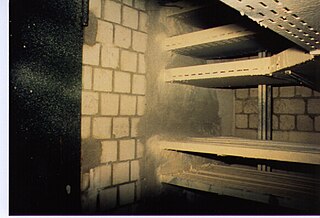
Passive fire protection (PFP) is components or systems of a building or structure that slows or impedes the spread of the effects of fire or smoke without system activation, and usually without movement. Examples of passive systems include floor-ceilings and roofs, fire doors, windows, and wall assemblies, fire-resistant coatings, and other fire and smoke control assemblies. Passive fire protection systems can include active components such as fire dampers.

A fitting or adapter is used in pipe systems to connect straight sections of pipe or tube, adapt to different sizes or shapes, and for other purposes such as regulating fluid flow. These fittings are used in plumbing to manipulate the conveyance of water, gas, or liquid waste in domestic or commercial environments, within a system of pipes or tubes.
Building officials of developed countries are generally the jurisdictional administrator of building and construction codes, engineering calculation supervision, permits, facilities management, and accepted construction procedures.

A grease trap is a plumbing device designed to intercept most greases and solids before they enter a wastewater disposal system. Common wastewater contains small amounts of oils which enter into septic tanks and treatment facilities to form a floating scum layer. This scum layer is very slowly digested and broken down by microorganisms in the anaerobic digestion process. Large amounts of oil from food preparation in restaurants can overwhelm a septic tank or treatment facility, causing the release of untreated sewage into the environment. High-viscosity fats and cooking grease such as lard solidify when cooled, and can combine with other disposed solids to block drain pipes.
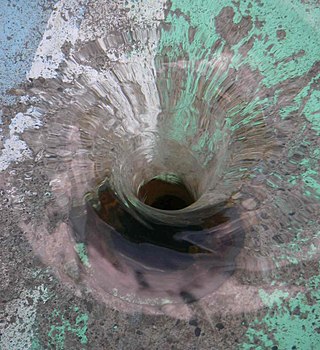
A drain is the primary vessel or conduit for unwanted water or waste liquids to flow away, either to a more useful area, funnelled into a receptacle, or run into sewers or stormwater mains as waste discharge to be released or processed.
The American Academy of Environmental Engineers and Scientists (AAEES) is a society of professional engineers and scientists who have demonstrated special expertise in environmental engineering or science beyond that normally required for professional practice. The principal purpose of the Academy is serving the public by improving the practice, elevating the standards, and advancing public recognition of environmental engineering and science through a program of specialty certification, similar to that used in healthcare and other professions.
The Virginia Graeme Baker Pool and Spa Safety Act (VGBA) is a United States law named after Virginia Graeme Baker, who died after sustaining a pool suction-drain injury in June 2002, when the suction from a spa drain entrapped her under the water. It is incorporated as Title 14 of the U.S. Energy Independence and Security Act of 2007. This act became enforceable law on December 19, 2008.
Plumbing Manufacturers International (PMI) is an industry association for manufacturers of plumbing products. Its members make 90% of the plumbing products sold in North America. Its headquarters is in Rolling Meadows, Illinois.
IAPMO R&T was started in 1936 as a third-party listing agency specializing in plumbing and mechanical products. IAPMO R&T is accredited to certify products that meet the criteria of the Uniform Plumbing Code, Uniform Mechanical Code, Uniform Solar Energy Code, Uniform Swimming Pool, Spa and Hot Tub Code and other nationally recognized codes and standards in North America.
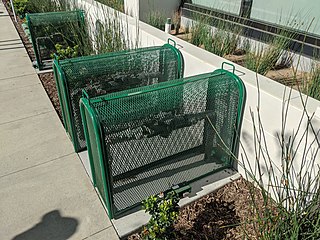
Backflow is a term in plumbing for an unwanted flow of water in the reverse direction. It can be a serious health risk for the contamination of potable water supplies with foul water. In the most obvious case, a toilet flush cistern and its water supply must be isolated from the toilet bowl. For this reason, building codes mandate a series of measures and backflow prevention devices to prevent backflow.

NSF is a product testing, inspection, certification organization with headquarters in Ann Arbor, Michigan. NSF also offers consulting and training services worldwide.
The Uniform Mechanical Code (UMC) is a model code developed by the International Association of Plumbing and Mechanical Officials (IAPMO) to govern the installation, inspection and maintenance of HVAC and refrigeration systems. It is designated as an American National Standard.
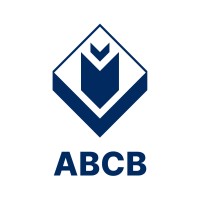
The Australian Building Codes Board (ABCB) is a body that writes Australia's standardized building requirements, including the National Construction Code (NCC), WaterMark, and CodeMark. The ABCB is part of a joint endeavour by the Commonwealth, state and territory governments, and the country's plumbing and building industries.
References
- 1 2 3 4 " William Whitehead (May 6, 2004). "Special PDI Supplement: A Closer Look at the Plumbing and Drainage Institute" (magazine). PM Engineer. Retrieved 2007-09-05.
- ↑ "Contact Us". Plumbing & Drainage Institute. Retrieved March 2, 2016.